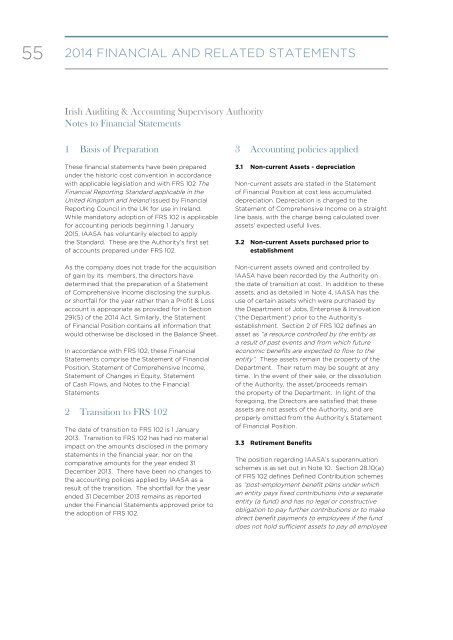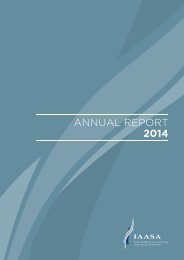Annual_Report2014
You also want an ePaper? Increase the reach of your titles
YUMPU automatically turns print PDFs into web optimized ePapers that Google loves.
55 2014 Financial and Related Statements<br />
Irish Auditing & Accounting Supervisory Authority<br />
Notes to Financial Statements<br />
1 Basis of Preparation<br />
These financial statements have been prepared<br />
under the historic cost convention in accordance<br />
with applicable legislation and with FRS 102 The<br />
Financial Reporting Standard applicable in the<br />
United Kingdom and Ireland issued by Financial<br />
Reporting Council in the UK for use in Ireland.<br />
While mandatory adoption of FRS 102 is applicable<br />
for accounting periods beginning 1 January<br />
2015, IAASA has voluntarily elected to apply<br />
the Standard. These are the Authority’s first set<br />
of accounts prepared under FRS 102.<br />
As the company does not trade for the acquisition<br />
of gain by its members, the directors have<br />
determined that the preparation of a Statement<br />
of Comprehensive Income disclosing the surplus<br />
or shortfall for the year rather than a Profit & Loss<br />
account is appropriate as provided for in Section<br />
291(5) of the 2014 Act. Similarly, the Statement<br />
of Financial Position contains all information that<br />
would otherwise be disclosed in the Balance Sheet.<br />
In accordance with FRS 102, these Financial<br />
Statements comprise the Statement of Financial<br />
Position, Statement of Comprehensive Income,<br />
Statement of Changes in Equity, Statement<br />
of Cash Flows, and Notes to the Financial<br />
Statements<br />
2 Transition to FRS 102<br />
The date of transition to FRS 102 is 1 January<br />
2013. Transition to FRS 102 has had no material<br />
impact on the amounts disclosed in the primary<br />
statements in the financial year, nor on the<br />
comparative amounts for the year ended 31<br />
December 2013. There have been no changes to<br />
the accounting policies applied by IAASA as a<br />
result of the transition. The shortfall for the year<br />
ended 31 December 2013 remains as reported<br />
under the Financial Statements approved prior to<br />
the adoption of FRS 102.<br />
3 Accounting policies applied<br />
3.1 Non-current Assets - depreciation<br />
Non-current assets are stated in the Statement<br />
of Financial Position at cost less accumulated<br />
depreciation. Depreciation is charged to the<br />
Statement of Comprehensive Income on a straight<br />
line basis, with the charge being calculated over<br />
assets’ expected useful lives.<br />
3.2 Non-current Assets purchased prior to<br />
establishment<br />
Non-current assets owned and controlled by<br />
IAASA have been recorded by the Authority on<br />
the date of transition at cost. In addition to these<br />
assets, and as detailed in Note 4, IAASA has the<br />
use of certain assets which were purchased by<br />
the Department of Jobs, Enterprise & Innovation<br />
(‘the Department’) prior to the Authority’s<br />
establishment. Section 2 of FRS 102 defines an<br />
asset as “a resource controlled by the entity as<br />
a result of past events and from which future<br />
economic benefits are expected to flow to the<br />
entity”. These assets remain the property of the<br />
Department. Their return may be sought at any<br />
time. In the event of their sale, or the dissolution<br />
of the Authority, the asset/proceeds remain<br />
the property of the Department. In light of the<br />
foregoing, the Directors are satisfied that these<br />
assets are not assets of the Authority, and are<br />
properly omitted from the Authority’s Statement<br />
of Financial Position.<br />
3.3 Retirement Benefits<br />
The position regarding IAASA’s superannuation<br />
schemes is as set out in Note 10. Section 28.10(a)<br />
of FRS 102 defines Defined Contribution schemes<br />
as “post-employment benefit plans under which<br />
an entity pays fixed contributions into a separate<br />
entity (a fund) and has no legal or constructive<br />
obligation to pay further contributions or to make<br />
direct benefit payments to employees if the fund<br />
does not hold sufficient assets to pay all employee



